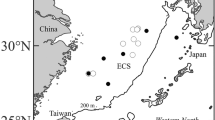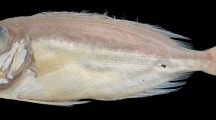Abstract
Yellowtail clownfish, Amphiprion clarkii (Bennett, 1830), is a member of the family Pomacentridae and are commonly occur in Indo-Pacific waters. It is a commercially important fish for ornamental trade worldwide. The present study aimed to study the molecular identification of three morphotypes of Amphiprion clarkii collected from Lakshadweep (vivid yellowish), Gulf of Mannar (golden yellowish), and Andaman Islands (dark black), respectively. Molecular characterization was carried out using, mitochondrial genes such as 12S, 16S and COI, the results showed that three morphotypes were found together with common clade and have not differed significantly. Additionally, the biogeographic distribution of the A. clarkii was studied in the Indo-Pacific Ocean. Three different populations have considerable genetic divergences such as the Indo-West Pacific Ocean, Papua New Guinea, and Australia populations, where environmental features and climatic conditions may play an important role in the evolutionary relationship of the continent.





Similar content being viewed by others
References
Ajith Kumar TT, Ghosh S, Balasubramanian T (2011) Clownfishes. Annamalai University, Tamil Nadu, India, p 32
Akash S, Purushothaman P, Madhavan M, Ravi C, Hisham T. J, Sudhakar M, Kumar T. A, Kuldeep LK (2020) Urocaridella arabianensis n. sp., a new Palaemonid shrimp (Crustacea, Decapoda, Palaemonidae) from Lakshadweep Islands, India with taxonomic comparison on the genus Urocaridella Borradaile, 1915. Zootaxa 4816(1): 49–66
Allen GR (1972) The anemonefishes: their classification and biology. Neptune City: TFH Publications, New York. USA. 1972. 288 pp
Allen GR (1975) Damselfishes of the South Seas. TFH Publications, Neptune City, USA, p 240
Allen GR (1991) Damselfishes of the world. MERGUS Publishers, Melle, p 271
Arlyza IS, Shen KN, Durand JD, Borsa P (2013) Mitochondrial haplotypes indicate parapatric-like phylogeographic structure in blue-spotted maskray (Neotrygon kuhlii) from the Coral Triangle region. J Hered 104(5):725–733
Bell LJ, Moyer JT, Numachi K (1982) Morphological and genetic variation in Japanese populations of the anemonefish Amphiprion Clarkii. J Mar Biol 72(2):99–108
Bell LJ (1976) Notes on the nesting success and fecundity of the anemonefish Amphiprion clarkii at Miyake-Jima Japan. Jpn J Ichthyol 22(4):207–211
Bernardi G (2011) Monophyletic origin of brood care in damselfishes. Mol Phylogenetics Evol 59(1):245–248
Biswas AK, Seoka M, Inoue Y, Takii K, Kumai H (2005) Photoperiod influences the growth, food intake, feed efficiency and digestibility of red sea bream (Pagrus major). Aquaculture 250(3–4):666–673
Cooper WJ, Smith LL, Westneat MW (2009) Exploring the radiation of a diverse reef fish family: phylogenetics of the damselfishes (Pomacentridae), with new classifications based on molecular analyses of all genera. Mol Phylogenetics Evol 52(1):1–16
Dhaneesh KV, Kumar TT, Kumar AB (2015) Barcoding, phylogeography and species boundaries in clownfishes of the Indian Ocean. DNA Barcodes 3:5–16
Dwivedi AK, Gupta BK, Singh RK, Mohindra V, Chandra S, Easawarn S, Jena J, Lal KK (2017) Cryptic diversity in the Indian clade of the catfish family Pangasiidae resolved by the description of a new species. Hydrobiologia 797(1):351–370
Elliott JK, Lougheed SC, Bateman B, McPhee LK, Boag PT (1999) Molecular phylogenetic evidence for the evolution of specialization in anemonefishes. P Roy Soc B-Biol SCI 266(1420):677–685
Endler JA (1981) An overview of the relationships between mimicry and crypsis. Biol J Linn Soc 16(1):25–31
Fautin DG, Allen GR, Allen GR, Naturalist A, Allen GR, Naturaliste A (1992) Field guide to anemone fishes and their host sea anemones. Western Australian Museum, Australia. 65 pp
Fautin DG, Allen GR (1997) Anemone fishes and their host sea anemones. a guide for aquarists and divers. Western Australian Museum, Australia. 160 pp
Frédérich B, Sorenson L, Santini F, Slater GJ, Alfaro ME (2013) Iterative ecological radiation and convergence during the evolutionary history of damselfishes (Pomacentridae). Am Nat 181(1):94–113
Fricke R, Eschmeyer WN, Vander Laan, R (2020) (Eds.), Eschmeyer’s Catalog of Fishes: genera, species, references. Electronic Version. Available from: http://researcharchive.calacademy.org/research/ichthyology/catalog/fishcatmain.asp. (Accessed 20 Nov 2020)
Fricke H, Fricke S (1977) Monogamy and sex change by aggressive dominance in coral reef fish. Nature 266(5605):830–832
Fricke HW (1980) Control of different mating systems in a coral reef fish by one environmental factor. Anim Behav 28(2):561–569
Fricke HW (1983) Social control of sex: field experiments with the anemonefish Amphiprion Bicinctus. Z Tierpsychol 61(1):71–77
Fricke HW (1974) Oko-etholgie des monogamen Anemonenfisches Amphiprion bicinctus. Z Tierpsychol 36:429–513
Froese R, Pauly D (2020) FishBase. World Wide Web electronic publication. [version 06/2020] https://www.fishbase.org
Ghosh S, Dhaneesh KV, Kumar TA, Kumaresan S, Balasubramanian T (2013) A New Record of Yellow Tail Anemonefish, Amphiprion clarkii (Bennett, 1830) from Tuticorin Tropical Waters. Southeast Coast of India ZSI 113(1):221–223
Ghosh S, Ajith Kumar TT, Nanthini devi K and Balasubramanian T (2012) Reef fish breeding and hatchery production using brackish water, A sustainable technology with special reference to Clark’s clownfish, Amphiprion clarkii (Bennett, 1830). Inter J Environ Sci Develop 3(1): 56 -60.
Hall TA (1999) BioEdit: a user-friendly biological sequence alignment editor and analysis program for Windows 95/98/NT. In Nucleic acids symposium series (Vol. 41, No. 41, pp. 95–98). [London]: Information Retrieval Ltd., c1979–c2000
Hatlen B, Arnesen AM, Jobling M, Siikavuopio S, Bjerkeng B (1997) Carotenoid pigmentation in relation to feed intake, growth and social interactions in Arctic charr, Salvelinus alpinus (L.), from two anadromous strains. Aquac Nutr 3(3): 189–199
Hattori A (2012) Determinants of body size composition in limited shelter space: why are anemonefishes protandrous? Behav Ecol 23(3):512–520
Henshaw J (2018) Protandrous hermaphroditism. Encyclopedia of animal cognition and behavior. Springer, Berlin. https://doi.org/10.1007/978-3-319-47829-6_1972-1
Horne JB, van Herwerden L, Choat JH, Robertson DR (2008) High population connectivity across the Indo-Pacific: congruent lack of phylogeographic structure in three reef fish congeners. Mol Phylogenetics Evol 49(2):629–638
Karakatsouli N, Papoutsoglou ES, Sotiropoulos N, Mourtikas D, Stigen-Martinsen T, Papoutsoglou SE (2010) Effects of light spectrum, rearing density and light intensity on growth performance of scaled and mirror common carp Cyprinus carpio reared under recirculating system conditions. Aquacult Eng 42(3):121–127
Karakatsouli N, Papoutsoglou SE, Panopoulos G, Papoutsoglou ES, Chadio S, Kalogiannis D (2008) Effects of light spectrum on growth and stress response of rainbow trout Oncorhynchus mykiss reared under re-circulating system conditions. Aquacult Eng 38(1):36–42
Kocher TD, Thomas WK, Meyer A, Edwards SV, Pääbo S, Villablanca FX, Wilson AC (1989) Dynamics of mitochondrial DNA evolution in animals: amplification and sequencing with conserved primers. PNAS USA 86(16):6196–6200
Kumar S, Stecher G, Li M, Knyaz C, Tamura K (2018) MEGA X: molecular evolutionary genetics analysis across computing platforms. MBEVEO 35(6):1547–1549
Mabuchi K, Nakabo T, Nishida M (2004) Molecular phylogeny of the antitropical genus Pseudolabrus (Perciformes: Labridae): evidence for a Southern Hemisphere origin. Mol Phylogenetics Evol 32(1):375–382
Moyer JT, Nakazono A (1978) Protandrous hermaphroditism in six species of the anemonefish genus Amphiprion in Japan. Jpn J Ichthyol 25(2):101–106
Moyer JT (1976) Geographical variation and social dominance in Japanese populations of the anemonefish Amphiprion clarkii. Jpn J Ichthyol 23(1):12–22
NBFGR (2013) DNA Barcoding and Molecular Taxonomy: Training manual. National Bureau of Fish Genetic Resources (NBFGR) Unit, Kochi, India. pp 57.
Neves JM, Almeida JP, Sturaro MJ, FabrÉ NN, Pereira RJ, Mott T (2020) Deep genetic divergence and paraphyly in cryptic species of Mugil fishes (Actinopterygii: Mugilidae). Syst Biodivers 18(2):116–128
Palanisamy SK, Kumar CP, Paramasivam P, Sundaresan U (2020) DNA barcoding of horn snail Telescopium telescopium (Linnaeus C, 1758) using mt-COI gene sequences. Reg Stud Mar Sci 35: 101109
Palumbi SR, Martin A, Romano SL, McMillian WO, Stice L, Grabowski G (1991) The simple fools guide to PCR, Version 2.0, University of Hawaii, Honolulu. 46 pp
Purushothaman P, Chakraborty RD, Kuberan G, Maheswarudu G (2019) Integrative taxonomy of commercially important deep water penaeoid shrimps from India. Genetics 98(1):12
Salis P, Lorin T, Laudet V, Frédérich B (2019) Magic traits in magic fish: understanding color pattern evolution using reef fish. Trends Genet 35(4):265–278
Schmiege PF, D’Aloia CC, Buston PM (2017) Anemonefish personalities influence the strength of mutualistic interactions with host sea anemones. J Mar Biol 164(1):24
Schultz JK, Pyle RL, DeMartini E, Bowen BW (2007) Genetic connectivity among color morphs and Pacific archipelagos for the flame angelfish Centropyge Loriculus. J Mar Biol 151(1):167–175
Sinha A, Kumari K, Singh S (2012) DNA Barcoding for species identification in Bamboos. ENVIS Forestry Bulletin 12(2):121
Tamazouzt L, Chatain B, Fontaine P (2000) Tank wall colour and light level affect growth and survival of Eurasian perch larvae (Perca fluviatilis L.). Aquaculture 182(1–2): 85–90
Tang KL (2001) Phylogenetic relationships among damselfishes (Teleostei: Pomacentridae) as determined by mitochondrial DNA data. Copeia 2001(3):591–601
Thompson JD, Higgins DG, Gibson TJ (1994) CLUSTAL W: improving the sensitivity of progressive multiple sequence alignment through sequence weighting, position-specific gap penalties and weight matrix choice. Nucleic Acids Res 22(22):4673–4680
Uthayasiva M, Haq MB, Kumar TA (2014) Significance of light intensity to enhance the colour of marine ornamental fish Amphiprion clarkii (Bennett, 1830) in captivity. J Fauna Biol 1(4):14–18
Ward RD, Zemlak TS, Innes BH, Last PR, Hebert PDN (2005) DNA barcoding Australia’s fish species. Philosophical Transactions of the Royal Society of London. J Biol Sci 360:1847–1857
Acknowledgements
The authors are thankful to the Director, ICAR—National Bureau of Fish Genetic Resources (NBFGR) for the facilities and encouragement. We are also extending gratitude to the authorities of Sree Narayana College, Cherthala, Kerala. Mangrove Foundation of Govt. of Maharashtra is acknowledged for financial support.
Author information
Authors and Affiliations
Corresponding author
Additional information
Publisher's Note
Springer Nature remains neutral with regard to jurisdictional claims in published maps and institutional affiliations.
Rights and permissions
About this article
Cite this article
S, V.D., S, S., Jose, S. et al. Molecular Characterization on the Morphotypes of Amphiprion clarkii (Bennett, 1830) from Indian Waters with Biogeographic Notes. Thalassas 37, 477–485 (2021). https://doi.org/10.1007/s41208-021-00330-3
Received:
Revised:
Accepted:
Published:
Issue Date:
DOI: https://doi.org/10.1007/s41208-021-00330-3




